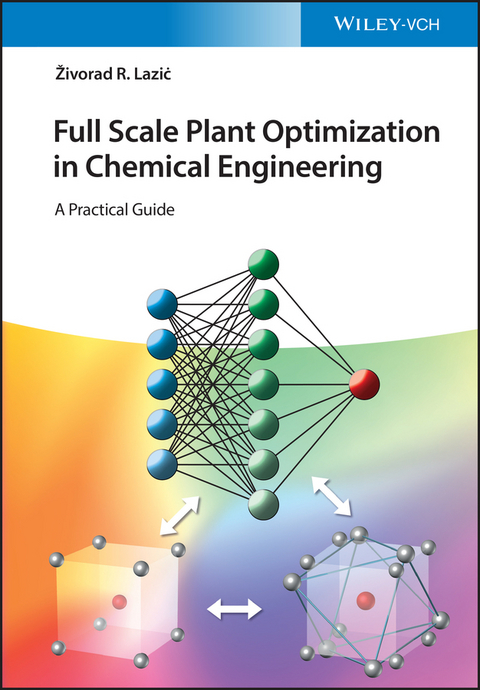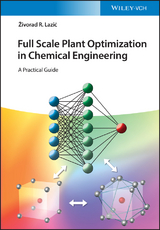Full Scale Plant Optimization in Chemical Engineering
Wiley-VCH (Verlag)
978-3-527-35038-4 (ISBN)
Zivorad R. Lazic is Quality Assurance Manager at Lenzing Fibers Corporation, Lowland, Tennessee, USA. Born in Ljubovija, Serbia, he completed his studies at Belgrade University, writing his thesis under the supervision of Prof. Dragoljub Vukovic. He began his career in Belgrade at the Military Technical Institute (VTI), where he was Head of Department for R&D into composite rocket propellants. He was trained at Hercules Inc., McGregor, TX, and spent more than six years as Vice President for Process and Product Development in P.T. South Pacific Viscose, Indonesia from 1994 until 2001.Dr. Lazic's interests include advanced statistical tools, DOE, SPC, EVOP, neural network modeling and the six-sigma approach.
Preface
I Basic Ideas
1.1 Introduction
II Design of Experiments (DOE)
2.1 22 Factorial Designs
2.2 Effects for the 22 Factorial Designs
2.3 Interactions Between Factors
2.4 Standard Error for the Effects
2.5 The 23 Factorial Design
2.6 Effects for the 23 Factorial Designs
2.7 Standard Errors of Effects for Two-Level Factorial Designs
III Neural Network Modeling-Data Mining
3.1 Data Preprocessing
3.2 Building, Training and Verifying the Model
3.3 Analyzing the Model
3.4 What-Ifs Optimization
3.5 DOE Experiment Using Neural Networks Model
IV Evolutionary Operation-EVOP
4.1 Small-Scale and Plant-Scale Investigation
4.2 Scale-Up
4.3 Static and Evolutionary Operation
4.4 Analysis of the Information Board
4.5 Three Factors Scheme
4.6 Current Best known Conditions
4.7 Change in Mean for a 22 Factorial Design with Center Point
4.8 Standard Errors for the Effects
4.9 The Effects and Their Standard Errors for a 22 Design with Center Point
4.10 Analysis of the Information Board for Three Responses Using the Factorial Effects
4.11 23 Factorial Design Effects, Interpretation and Information Board
4.12 Dividing the 23 Factorial Design Into Two Blocks
4.13 23 Design with Two Center Points Run in Two Blocks
V Different Techniques of EVOP
5.1 Box EVOP-BEVOP
5.2 Calculation Procedure for Two Factors EVOP
5.3 Conclusions from the Information Board
5.4 Calculation Procedure for the Three Factors EVOP
5.5 BEVOP in Plant-Scale Experiments
5.6 BEVOP Application
5.7 BEVOP Advantages & Disadvantages
5.8 BEVOP Simulation
5.8.1 22 BEVOP Simulation
5.8.2 23 BEVOP Simulation
5.9 Rotating Square Evolutionary Operation-ROVOP
5.9.1 22 ROVOP Simulation
5.9.2 Method of Analysis
5.9.3 22 ROVOP Simulation
5.9.4 23 ROVOP Simulation
5.10 Random Evolutionary Operation-REVOP
5.10.1 REVOP Simulation
5.11 Quick Start EVOP-QSEVOP
5.11.1 QSEVOP Simulation
5.12 Simplex Evolutionary Operation-SEVOP
5.12.1 The Basic Simplex Method
5.12.2 Simplex Evolutionary Operation-SEVOP
5.12.3 SEVOP Simulation
5.13 Some Practical Advice About Using EVOP
VI EVOP Software
VII. Appendix
A-I The Approximate Method of Estimating the Standard Deviation in EVOP
A-II 22 Two Factors Box EVOP Calculations with the Center Point
A-III Short Table of Random Normal Deviates
A-IV How Many Cycles Are Necessary to Detect Effects of Reasonable Size
| Erscheinungsdatum | 06.07.2022 |
|---|---|
| Verlagsort | Weinheim |
| Sprache | englisch |
| Maße | 170 x 244 mm |
| Gewicht | 672 g |
| Themenwelt | Naturwissenschaften ► Chemie ► Technische Chemie |
| Technik ► Bauwesen | |
| Schlagworte | Bauingenieur- u. Bauwesen • chemical engineering • Chemie • Chemische Verfahrenstechnik • Chemistry • Civil Engineering & Construction • Computer-aided Engineering • Computergestützte Verfahrenstechnik • Environmental Engineering • Industrial Chemistry • Industrielle Chemie • Technische u. Industrielle Chemie • Umwelttechnik |
| ISBN-10 | 3-527-35038-1 / 3527350381 |
| ISBN-13 | 978-3-527-35038-4 / 9783527350384 |
| Zustand | Neuware |
| Informationen gemäß Produktsicherheitsverordnung (GPSR) | |
| Haben Sie eine Frage zum Produkt? |
aus dem Bereich




